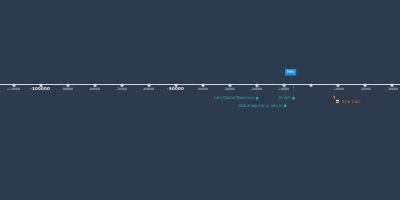Iron Age (jan 1, 800 BC – jan 1, 15 BC)
Description:
Iron Age: 800 BC- 15 BC (in northwest Europe, 15 BC is conquest by Romans)- The crucial difference between using bronze or iron is that iron is stronger and unlike copper and tin, iron can be found almost everywhere in Europe (no need for vast exchange networks);
- Iron is often won from iron pans in streams and bogs;
- iron is forged, it cannot be cast and copied like bronze. In prehistory, there were no techniques to smelt and cast iron (these only were used in modern times);
- the Greek colonies were founded between 740 BC-4th century BC;
> they were made to trade with ‘barbarians’ in the north like Celtic or Scythian tribes;
- as a result of such trade connections, elites emerged in Barbarian Europe: the Hallstatt elites;
- the colony of Massilia was important as it maintained connections with a Hallstatt power centre the Heuneburg (Germany) and Vix, east France;
- Hallstatt elite culture involved burial of four-wheeled wagons, horse gear, bronze situlae (big vessels for alcoholic drinks like mead) and swords;
- the chieftain’s grave of Oss is an early example of such a grave- here all objects were ritually transformed (bent sword f.i.);
- the richest grave is the grave from Vix (East France); 6th century BC- this is the grave of a female;
- La Tène style is the successor to Hallstatt and is usually associated with people known from historical sources as ‘the Celts’;
- La Tène style is characterized by abstract complex spiraling patterns;
- ‘Celts’ are called ‘Gauls’ in sources on ancient France;
- Celt is a difficult to pin down concept- it refers both to specific languages like Gaelic or Welsh, to art style (La Tène), to enemies of the Greeks and Romans (Celts, Gauls);
- ‘Celtic’ people often lived in semi-urbanized hillforts called ‘oppidum’ (plural: oppida);
- Gauls have rectangular enclosures for sanctuaries in which the deposited weapon booty and sometimes bodies of dead enemies;
- Gauls had a stratified centralized organisation with kings;
- Germanic tribes lived north of the Celts and had a more simple, loose social organisation;
- among Germanic tribes, human sacrifice occurred: bodies found in peat bogs are thought to be remains of these;
- Romans increasingly conquered parts of Europe; Gaul was conquered in 52 BC and they reached Germanic regions including the Netherlands, in 15 BC;
- from 48 AD onwards the border of the Roman empire run through the Netherlands – right here in Leiden – and followed the course of the river Rhine;
14
- the Gauls were more easily conquered by the Romans than the Germanic tribes, because the Germanic tribes lacked a centralised organisation and could resort to guerrilla-like warfare.
Added to timeline:
Date:
jan 1, 800 BC
jan 1, 15 BC
~ 785 years
